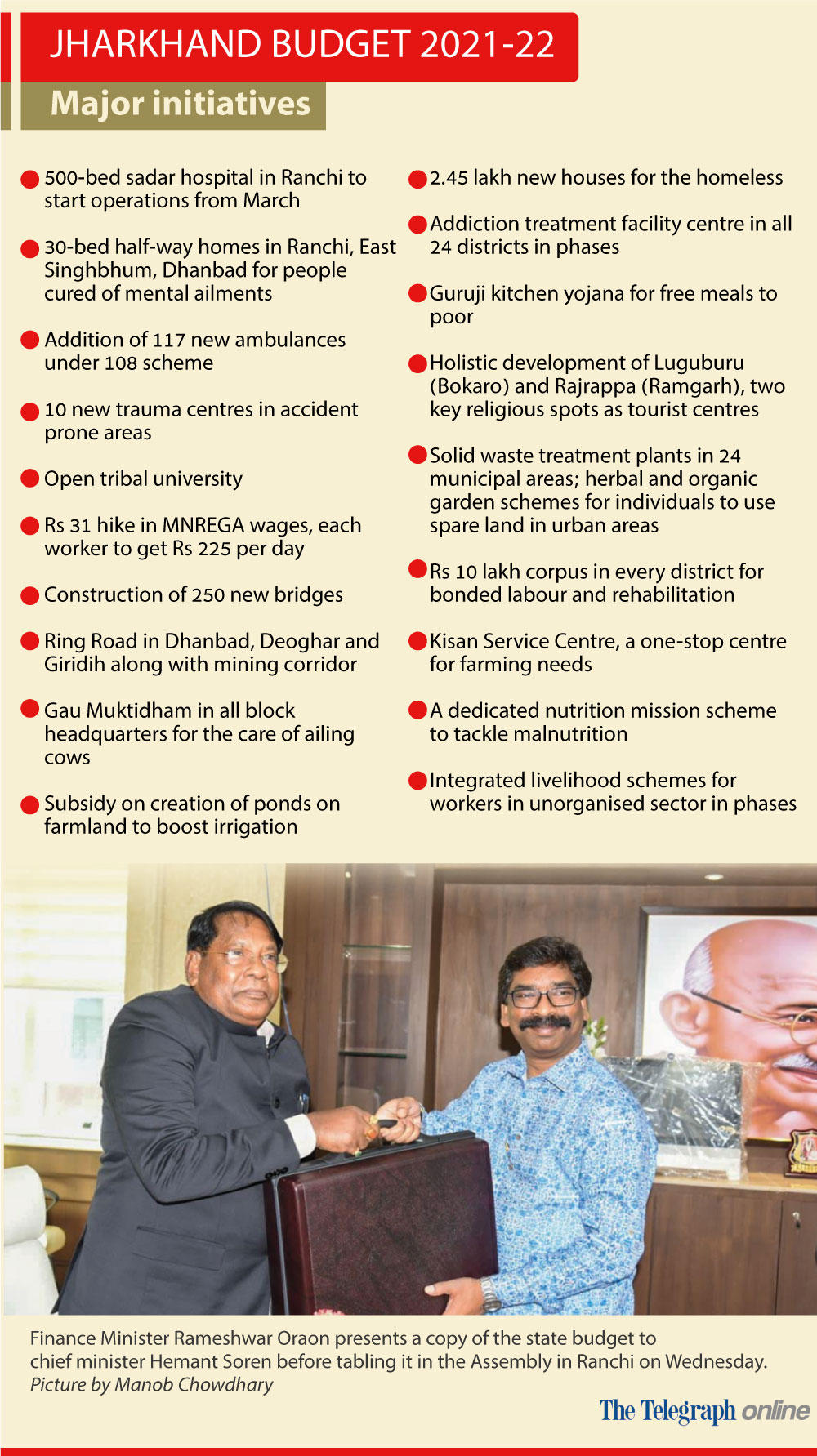The Hemant Soren government tabled a budget of Rs 91,277 crore for the 2021-22 fiscal on Wednesday with a major thrust on rural development, education, health and social welfare schemes to counter challenges posed by the Covid-19 pandemic.
No new taxes were announced, but state finance minister Rameshwar Oraon unveiled a slew of welfare measures including a universal pension scheme for widows and the elderly, a centralised one-stop helpline for senior citizens, Guruji kitchen yojana, scholarships for ST students to pursue higher studies in foreign varsities and extension of farm loan waivers.
Many of these schemes were announced earlier when the JMM-Congress-RJD alliance government completed one year in December last year but were included in the budget now to pave the way for their rollout.

Graphic: The Telegraph Online
Major budget allocations were split into three broad categories — general, social and economic sectors. The maximum allocation was set aside for the social sector (Rs 33,625.72 crore), followed by the economic sector (Rs 30,917.23 crore) and general sector (Rs 26,734.50 crore).
Chief minister Hemant Soren described the budget as a “template of long-term planning” with the aim of balancing both rural and urban concerns.
According to the budget document, of the total estimates, receipts comprise of 25.49 per cent receipts are from state revenues, 24.16 per cent from the state’s share in central taxes, 14.79 per cent from state’s own taxes, 19.60 per cent from grants in aids, form borrowings 15.89 per cent and from recovery of loans/advances 0.7 per cent.
Similarly, spending per rupee will be 14.54 per cent for education, 14.16 per cent for rural development, 8.55 per cent for health and drinking water, 8.05 per cent for social welfare/welfare, 6.28 per cent for agriculture & allied services, 4.78 per cent for energy, 3.10 per cent for urban development and housing, among others.
Speaking to reporters after the day’s House proceedings, Oraon said the fiscal deficit for 2021-22 has been pegged at Rs 10,210.87 crore which is 2.83 per cent of GSDP. “In 2019-20, the state’s growth rate stood at 6.7 per cent which suffered a hit due to the global pandemic as per the nationwide trend. In the current fiscal, the nation’s GDP is expected to fall by 7.5 per cent. In Jharkhand, it is expected to contract by 6.9 per cent. Compared to the national trend, we are slightly better placed,” he said, adding that in the next fiscal, the state’s growth rate is expected to be about 9.5 per cent.
Chief minister Hemant Soren hailed the budget as a template of long-term planning. He said the government has tried to balance both rural and urban concerns to ensure a congenial environment for all to earn a suitable livelihood, improve living conditions and be self-sufficient.

Chief minister Hemant Soren poses with protesting BJP MLAs in the Assembly as a gesture of goodwill after the presentation of the state budget in the Assembly in Ranchi on Wednesday. Picture by Manob Chowdhary
“Unlike the earlier government, which devised most of the policies keeping short-term gains in mind, we have set a long-term vision to steer growth. Results too will be visible gradually. We have seen how the state’s economy went for toss during the time of the ‘during double engine government’,” Hemant said, adding that for the first time the government also tabled an outcome budget along with the state budget for about a dozen departments.
“The purpose of the outcome budget is to tell the public the kind of end results the government is expecting from that particular department through various schemes,” he explained.











